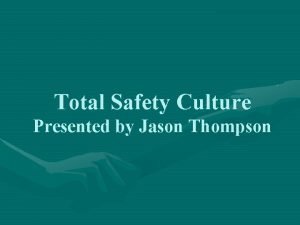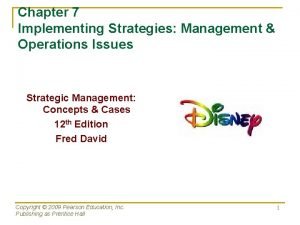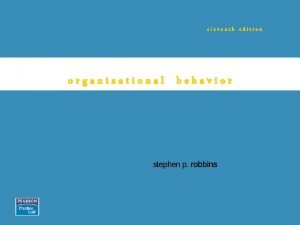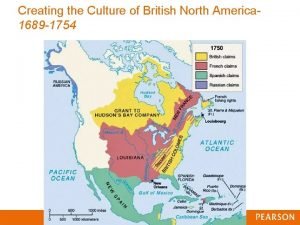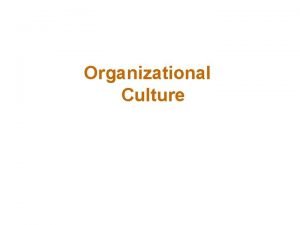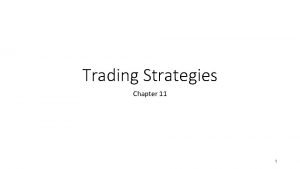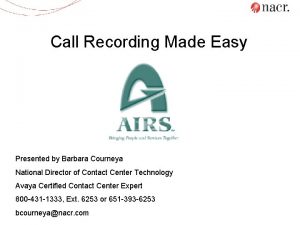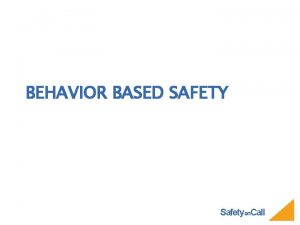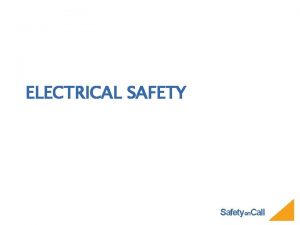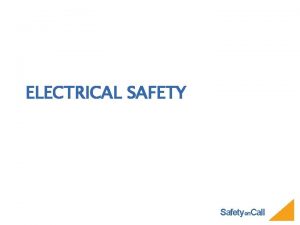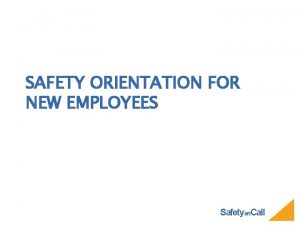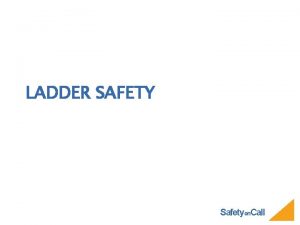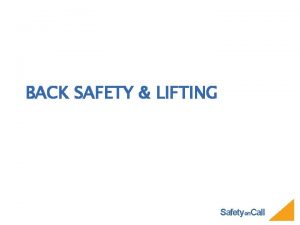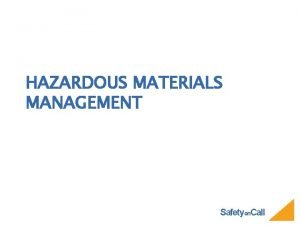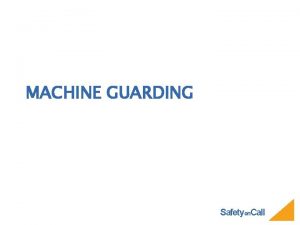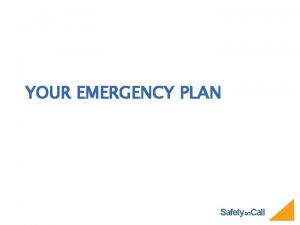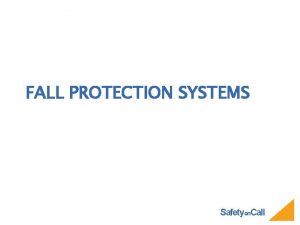CREATING A TOTAL SAFETY CULTURE Safetyon Call GOALS













- Slides: 13

CREATING A TOTAL SAFETY CULTURE Safetyon. Call

GOALS • A “Safety Culture” cannot be developed fully in a short presentation. Therefore, this presentation is offered to help: ₋ Develop an awareness of and to value the importance of making safety an integral part of a company’s culture. ₋ Develop an awareness of the importance of accountability in an effective safety program. Safetyon. Call

WHAT IS A SAFETY CULTURE • A safety culture is the result of: ₋ Management and employee attitude. ₋ Policies and procedures. ₋ Supervisory responsibility and accountability. ₋ Safety planning and goals. ₋ Actions in response to unsafe behavior. ₋ Employee training and motivation. ₋ Employee involvement or “buy in”. Safetyon. Call

HOW TO DEVELOP A SAFETY CULTURE The sequence of steps necessary to create a safety culture is: 1. Awareness through communication, safety posters, warning signs and safety handouts, and having safety be an integral part of the workplace. 2. Recognition through observation, inspections, safety committees and incentive programs. 3. Corrective action and change through investigation of accidents and near-hits; determination of symptoms and root-cause corrective action; and behavioral changes. 4. Education through management and employee training. 5. Accountability through “chargeback” systems, safety goals, safety activities and documentation. 6. Results and benefits through reduced costs, increased productivity, improved production schedules, improved customer service, and job security and personal health. Safetyon. Call

AWARENESS – WHY A SAFETY CULTURE • Every accident has an impact on profits and sales. An accident with medical costs of $1, 000 can cost $5, 000 in total; to pay those costs, a company must sell $100, 000 of product. • Every accident has an impact on WC and insurance. Insurance rate (premiums) rise as comp costs rise. • Every accident has legal implications. Litigation is on the rise. • Why a safety culture? Because a company cannot afford to not adopt a safety culture. Safetyon. Call

RECOGNITION – THE ART OF OBSERVATION • Observation & Recognition Techniques: ₋ Understand the objective of the work activity being observed. ₋ Be familiar with the standard/accepted methodology for completing the task under observation. ₋ Look for attitude, regardless of behavior. ₋ Trust your initial impression. ₋ Know the facility’s accident history. ₋ Document findings. ₋ Have an immediate reaction. Safetyon. Call

CORRECTIVE ACTION AND CHANGE – THE INVESTIGATIVE PROCESS • This process includes three production factors involved in all operations. 1. Equipment • Was it used properly? • Was it selected properly? • Was it maintained properly? 2. Materials • Were proper materials handling techniques used? • Were employees exposed to any hazardous materials? 3. People/Behavior • How are employees selected? • How are they trained? • How are they motivated? Safetyon. Call

DIFFERENTIATE BETWEEN UNSAFE ACTS & UNSAFE CONDITIONS • Ninety percent of accident causes are unsafe acts. • Causes that are left uncorrected will result in serious accidents. Common examples of causes include: ₋ Inadequate employee training. ₋ Ineffective employee motivation. ₋ Lack of accountability. ₋ Inadequate policies and procedures. ₋ Improper selection of equipment or material. ₋ Poor maintenance of facilities or equipment. Safetyon. Call

EDUCATION – EMPLOYEE TRAINING • Some 43. 5 percent of all accidents occur during the first year of service. • Here’s a useful training sequence to try: 1. Prepare the worker (attitude). 2. Present the job (knowledge). 3. Involve the employee (skill). 4. Follow up (accountability). Training is ongoing- it never ends. Safetyon. Call

ACCOUNTABILITY – THE ART OF MOTIVATION • Someone is held accountable when his/her performance is measured in relation to standards or goals. • Accountability can be established in safety through three methods: 1. Chargeback system. 2. Safety goal system. 3. Safety activities. Good leadership provides the motivation to achieve goals. Safetyon. Call

GOOD MANAGEMENT PRACTICES • Accountability ₋ Establish achievable goals. ₋ Provide feedback on progress on a regular basis. ₋ Provide meaningful rewards when safety goals are met. • Planning ₋ Set priorities for safety along with productivity, quality and scheduling. ₋ Identify unusual job hazards in advance. ₋ Eliminate unsafe shortcuts or methods. ₋ Plan for equipment, material and people-materials handling, PPE, new employees. Safetyon. Call

PERSONAL EXAMPLE • Set an example for safe behavior. Be a leader. • Show commitment to safety. Be assertive. • Enforce safe operations and job procedures. Be decisive. • Participate in safety activities, meetings, inspections, etc. • Wear proper PPE. • Give credit when due. Be supportive. • Listen to workers. Be available. • Show a positive attitude. Be enthusiastic. • Inspire a team effort. Be a coach. Safetyon. Call

• A safety culture can produce many results and benefits for both the company and its employees: ₋ WC costs are reduced. ₋ The experience modification factor is reduced. ₋ Direct and indirect costs of accidents as well as overall operating costs are reduced. ₋ Productivity improves when accidents are prevented. ₋ Profit margins increase when fewer accidents occur. ₋ Production schedules and delivery times are improved. ₋ The potential for legal costs is reduced. ₋ Job security, job satisfaction and personal well-being are improved. Safetyon. Call
 Strategic goals tactical goals operational goals
Strategic goals tactical goals operational goals Strategic goals tactical goals operational goals
Strategic goals tactical goals operational goals Total safety leadership
Total safety leadership Creating a strategy supportive culture
Creating a strategy supportive culture Entry socialization options
Entry socialization options Creating the culture of british north america
Creating the culture of british north america Institutionalization organizational culture
Institutionalization organizational culture General goals and specific goals
General goals and specific goals Motivation in consumer behaviour
Motivation in consumer behaviour Protective put payoff
Protective put payoff Stock options terminology
Stock options terminology Gartner call recording magic quadrant
Gartner call recording magic quadrant Activo promedio
Activo promedio Total revenues minus total costs equals
Total revenues minus total costs equals


